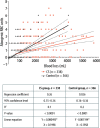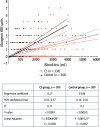The association between intraoperative cell salvage and red blood cell transfusion in cardiac surgery - an observational study in a patient blood management centre
- PMID: 33625822
- PMCID: PMC10158449
- DOI: 10.5114/ait.2021.103735
The association between intraoperative cell salvage and red blood cell transfusion in cardiac surgery - an observational study in a patient blood management centre
Abstract
Introduction: Cell salvage (CS) is an integral part of patient blood management (PBM) and aims to reduce allogeneic red blood cell (RBC) transfusion.
Material and methods: This observational study analysed patients scheduled for elective cardiac surgery requiring cardiopulmonary bypass (CPB) between November 2015 and October 2018. Patients were divided into a CS group (patients receiving CS) and a control group (no CS). Primary endpoints were the number of patients exposed to allogeneic RBC transfusions and the number of RBC units transfused per patient.
Results: A total of 704 patients undergoing cardiac surgery were analysed, of whom 338 underwent surgery with CS (CS group) and 366 were without CS (control group). Intraoperatively, 152 patients (45%) were exposed to allogeneic RBC transfusions in the CS group and 93 patients (25%) in the control group (P < 0.001). Considering the amount of intraoperative blood loss, regression analysis revealed a significant association between blood loss and increased use of RBC units in patients of the control compared to the CS group (1000 mL: 1.0 vs. 0.6 RBC units; 2000 mL: 2.2 vs. 1.1 RBC units; 3000 mL: 3.4 vs. 1.6 RBC units). Thus, CS was significantly associated with a reduced number of allogeneic RBCs by 40% for 1000 mL, 49% for 2000 mL, and 52% for 3000 mL of blood loss compared to patients without CS.
Conclusions: Cell salvage was significantly associated with a reduced number of allogeneic RBC transfusions. It supports the beneficial effect of CS in cardiac surgical patients as an individual measure in a comprehensive PBM program.
Keywords: cardiac surgery; patient blood management; transfusion.; cell salvage.
Conflict of interest statement
P.M. and K.Z. received grants from B. Braun Melsungen, CSL Behring, Fresenius Kabi, and Vifor Pharma for the implementation of Frankfurt’s Patient Blood Management program and honoraria for scientific lectures from B. Braun Melsungen, Vifor Pharma, Ferring, CSL Behring, and Pharmacosmos. For the remaining authors, none were declared.
Figures



Similar articles
-
The efficacy, safety and cost-effectiveness of intra-operative cell salvage in high-bleeding-risk cardiac surgery with cardiopulmonary bypass: a prospective randomized and controlled trial.Int J Med Sci. 2015 Apr 1;12(4):322-8. doi: 10.7150/ijms.11227. eCollection 2015. Int J Med Sci. 2015. PMID: 25897293 Free PMC article. Clinical Trial.
-
Comprehensive perioperative blood management in patients undergoing elective bypass cardiac surgery: Benefit effect of health care education and systematic correction of iron deficiency and anemia on red blood cell transfusion.J Clin Anesth. 2024 Nov;98:111560. doi: 10.1016/j.jclinane.2024.111560. Epub 2024 Aug 14. J Clin Anesth. 2024. PMID: 39146724
-
Intraoperative cell salvage is associated with reduced postoperative blood loss and transfusion requirements in cardiac surgery: a cohort study.Transfusion. 2013 Nov;53(11):2782-9. doi: 10.1111/trf.12126. Epub 2013 Feb 27. Transfusion. 2013. PMID: 23445352
-
Benefits and risks of red blood cell transfusion in pediatric patients undergoing cardiac surgery.Paediatr Anaesth. 2011 May;21(5):504-11. doi: 10.1111/j.1460-9592.2010.03464.x. Epub 2010 Nov 29. Paediatr Anaesth. 2011. PMID: 21114707 Review.
-
Safety of Salvaged Blood and Risk of Coagulopathy in Cardiac Surgery.Semin Thromb Hemost. 2016 Mar;42(2):166-71. doi: 10.1055/s-0035-1569067. Epub 2016 Feb 2. Semin Thromb Hemost. 2016. PMID: 26838699 Review.
Cited by
-
Successful Case of Double Valve Replacement Surgery Using Autologous Blood Transfusion: A Patient's Autonomy Preserved with Excellent Clinical Outcome.Am J Case Rep. 2024 Jul 24;25:e943675. doi: 10.12659/AJCR.943675. Am J Case Rep. 2024. PMID: 39046936 Free PMC article.
-
Preoperative anaemia and red blood cell transfusion in patients with aneurysmal subarachnoid and intracerebral haemorrhage - a multicentre subanalysis of the German PBM Network Registry.Acta Neurochir (Wien). 2022 Apr;164(4):985-999. doi: 10.1007/s00701-022-05144-7. Epub 2022 Feb 26. Acta Neurochir (Wien). 2022. PMID: 35220460 Free PMC article.
-
2024 EACTS/EACTAIC/EBCP Guidelines on cardiopulmonary bypass in adult cardiac surgery.Eur J Cardiothorac Surg. 2025 Feb 4;67(2):ezae354. doi: 10.1093/ejcts/ezae354. Eur J Cardiothorac Surg. 2025. PMID: 39949326 Free PMC article. No abstract available.
-
Intraoperative Cell Savage, Infection and Organ Failure in Infective Endocarditis Patients-A Retrospective Single Center Evaluation.J Clin Med. 2023 Jan 3;12(1):382. doi: 10.3390/jcm12010382. J Clin Med. 2023. PMID: 36615185 Free PMC article.
-
Turbulence in surgical suction heads as detected by MRI.J Extra Corpor Technol. 2023 Jun;55(2):70-81. doi: 10.1051/ject/2023015. Epub 2023 Jun 28. J Extra Corpor Technol. 2023. PMID: 37378439 Free PMC article.
References
Publication types
MeSH terms
LinkOut - more resources
Full Text Sources
Other Literature Sources
Medical
